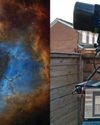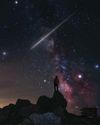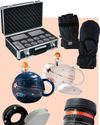
This month's project helps you aim your scope at a target in the night sky. It is called a zero-magnification finder because the view is the same size as seen with your naked eye. The finder projects a red circle onto the background sky and you move your telescope to align the centre of this circle with your target. Many stargazers use similar devices because they allow you to keep both eyes open and see a much larger area of sky, making it easier to jump to the target.
Our design has a red LED that illuminates the white interior of the front of the case. The LED is powered by a coin cell battery, via a switch on the back panel. The red light is reflected backwards through a clear glass screen, painted matt black except for a small ring in the centre. The light is then reflected upwards by a mirror mounted at 45° and through a lens, which produces a sharp image. This is reflected backwards again by a glass viewing screen, mounted at 45° in a hood. When the distant sky is viewed through this screen, the red circle is superimposed on it.
We sourced the components for this project imaginatively to keep the cost down. The LED, coin cell holder and switch are from an educational supplier. The clear glass was cut from an old picture frame, and we used the frame's thin MDF backing to make the case. The front surface mirror is a disposable dentist's mirror. We found these online, along with the lens, a Fresnel magnifier sheet.
Mounting matters
Diese Geschichte stammt aus der February 2023-Ausgabe von BBC Sky at Night Magazine.
Starten Sie Ihre 7-tägige kostenlose Testversion von Magzter GOLD, um auf Tausende kuratierte Premium-Storys sowie über 8.000 Zeitschriften und Zeitungen zuzugreifen.
Bereits Abonnent ? Anmelden
Diese Geschichte stammt aus der February 2023-Ausgabe von BBC Sky at Night Magazine.
Starten Sie Ihre 7-tägige kostenlose Testversion von Magzter GOLD, um auf Tausende kuratierte Premium-Storys sowie über 8.000 Zeitschriften und Zeitungen zuzugreifen.
Bereits Abonnent? Anmelden

Putting cosmic rays to work
These penetrating interstellar particles have applications from astronomy to archaeology

Set up your first imaging sequence
How to automate and coordinate your gear over multiple nights of imaging

The Universe without gravity
Life with no gravity might sound a fun idea, but as Govert Schilling explains, shutting off this pivotalforce would spell disaster for Earth and beyond

How to blend images taken with different camera setups
Combine data captured at varied focal lengths to create rich, deep images

INSIDE THE SKY AT NIGHT
Back in September 2021, The Sky at Night show spoke to Carly Howett about NASA's then upcoming Lucy mission. As the spacecraft now approaches its main targets - the Trojan asteroids - we check in with her to see how the mission is going

The science of SCI-FI
We love a good sci-fi film, but do they get the science right? Amy Arthur picks six of the big mistakes made in space films

Seeing in a new light
It's National Astronomy Week this month, so take a tip from Mark Westmoquette and let mindful stargazing change your perspective on your life and problems

What to do if you find a meteorite
Ever come across an unusual rock and wondered if it's a meteorite? Mark McIntyre explains how to tell if that stone really is a fragment from outer space

GEAR
Charlotte Daniels rounds up the latest astronomical accessories

Q&A WITH A STELLAR ECLIPSE SPECIALIST
Many stars are gravitationally locked inside multi-star systems, but a rare new triple-star system has set a new record for how cosy these clusters can get